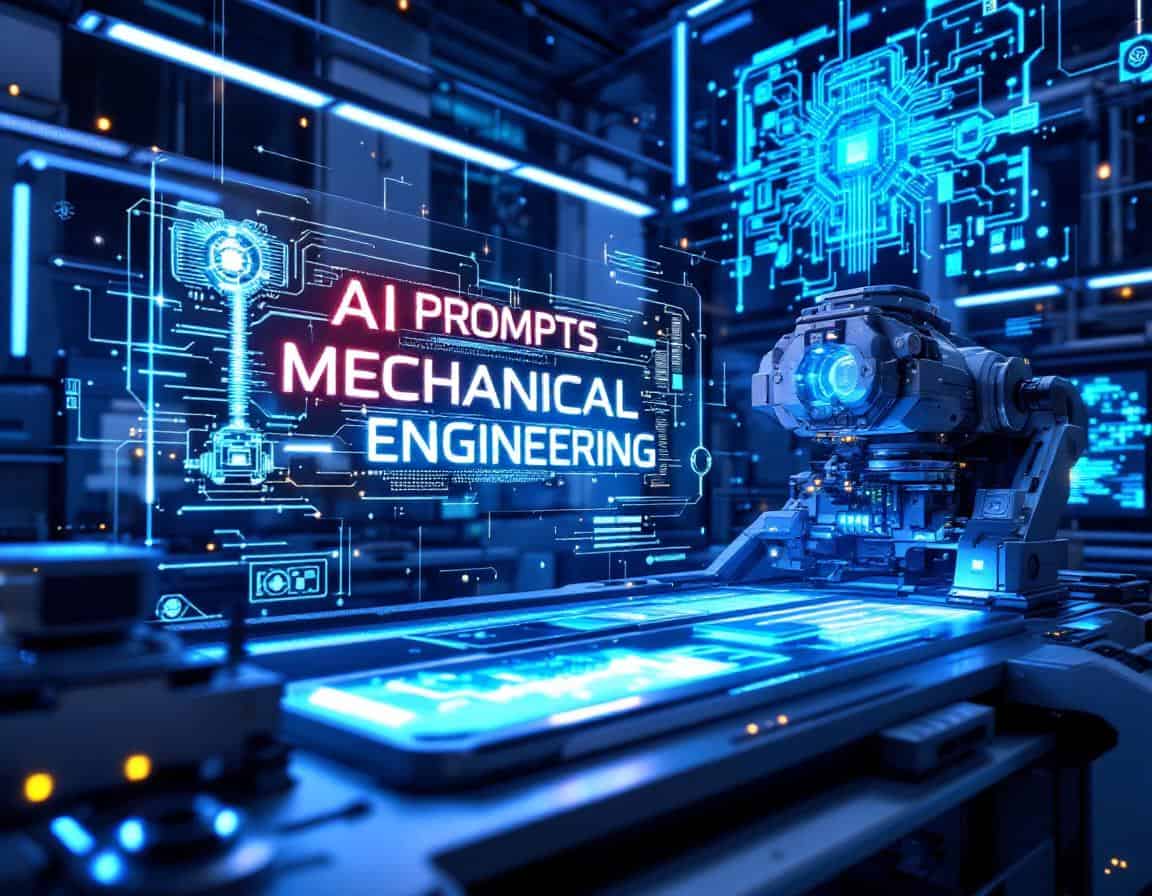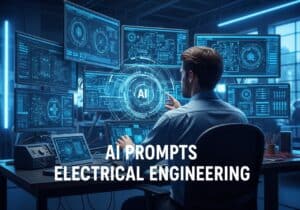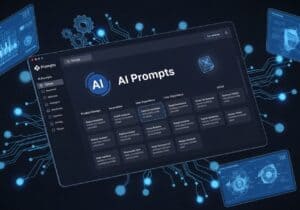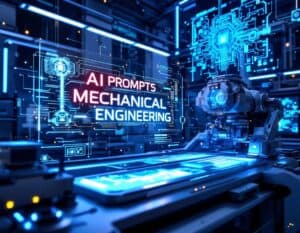
Online-KI-Tools verändern den Maschinenbau rapide, indem sie die menschlichen Fähigkeiten in den Bereichen Konstruktion und Analyse ergänzen, Herstellungund Wartung. Diese KI-Systeme können riesige Datenmengen verarbeiten, komplexe Muster erkennen und neue Lösungen viel schneller als herkömmliche Methoden entwickeln. So kann KI Sie beispielsweise bei der Optimierung von Konstruktionen im Hinblick auf Leistung und Herstellbarkeit unterstützen, komplexe Simulationen beschleunigen, Materialeigenschaften vorhersagen und eine Vielzahl von Analyseaufgaben automatisieren.
Die nachstehenden Hinweise helfen zum Beispiel bei der generativen Konstruktion, beschleunigen Simulationen (FEA/CFD), helfen bei der vorausschauenden Wartung, bei der KI Sensordaten von Maschinen analysiert, um potenzielle Ausfälle vorherzusagen, ermöglichen eine proaktive Wartung und minimieren Ausfallzeiten, helfen bei der Materialauswahl und vieles mehr.
- Diese Seite ist spezifisch für eine Domain. Bei Bedarf können Sie in unserer > Suchmaschine nach allen Domains und allen Kriterien suchen. AI Prompts Verzeichnis <, gewidmet dem Produktdesign Und Innovation.
- Angesichts der Server-Ressourcen und des Zeitaufwands sind die Eingabeaufforderungen selbst nur registrierten Mitgliedern vorbehalten und unten nicht sichtbar, wenn Sie nicht angemeldet sind. Sie können sich registrieren, 100% kostenlos:
Mitgliedschaft erforderlich
Sie müssen Mitglied sein, um auf diesen Inhalt zugreifen zu können.
- Ursachenanalyse
- Maschinenbau
AI Aufforderung an Builder für die Fehlerbaumanalyse
- Analyse des Versagens, Fehlermöglichkeits- und Einflussanalyse (FMEA), Fehlerbaumanalyse (FTA), Maschinenbau, Prozessverbesserung, Qualitätskontrolle, Qualitätsmanagement, Risikoanalyse, Risikomanagement
Diese Eingabeaufforderung fordert die KI auf, ein Fehlerbaumanalysediagramm im Textformat für ein bestimmtes mechanisches Systemfehlerereignis zu erstellen. Der Benutzer gibt die Beschreibung des Fehlerereignisses und die beteiligten Komponenten an.
Ausgabe:
- Markdown
- erfordert kein Live-Internet
- Felder: {failure_event} {system_components}
Construct a fault tree analysis for the mechanical failure event described as: {failure_event}. Consider the following system components: {system_components}. Present the fault tree in markdown using indentation and bullet points to represent logical AND/OR gates and failure paths. Include explanations of each branch and possible root causes. Use uppercase for failure events and lowercase for components.
- Am besten geeignet für: Am besten geeignet für die Visualisierung von Fehlerfortpflanzung und Abhängigkeiten in mechanischen Systemen
- Ethische Erwägungen und Folgenanalyse
- Maschinenbau
AI Aufforderung an Analyse der politischen Folgen für mechanische Innovationen
- Umweltauswirkungen, Umwelttechnologien, Innovationsstrategie, Qualitätsmanagement, Verordnung, Risikomanagement, Normen, Nachhaltigkeitspraktiken, Nachhaltige Entwicklung
Diese Aufforderung weist die KI an, die politischen und regulatorischen Auswirkungen der Einführung einer neuen Innovation im Maschinenbau zu bewerten. Der Benutzer gibt die Beschreibung der Innovation und die Zielregion oder das Zielland an, um die Analyse auf die relevanten Gesetze und Normen zuzuschneiden.
Ausgabe:
- Text
- erfordert Live-Internet
- Felder: {innovation_description} {target_region}
Evaluate the policy and regulatory implications of the following mechanical engineering innovation: {innovation_description}. Focus your analysis on the target region or country: {target_region}. Outline existing regulations, standards, and compliance requirements that could affect deployment. Provide recommendations on policy adaptation or lobbying strategies to facilitate innovation adoption. Use numbered lists and clear subheadings to organize your response.
- Am besten geeignet für: Am besten geeignet für das Verständnis und die Navigation von rechtlichen und politischen Rahmenbedingungen, die sich auf Maschinenbau-Projekte auswirken
- Ethische Erwägungen und Folgenanalyse
- Maschinenbau
AI Aufforderung an Generator für ethische Dilemma-Szenarien für Ingenieure
- Kontinuierliche Verbesserung, Design für Nachhaltigkeit, Technische Grundlagen, Umweltauswirkungen, Human-Centered Design, Innovation, Maschinenbau, Risikomanagement
Diese Aufforderung fordert die KI auf, realistische ethische Dilemma-Szenarien zu erstellen, die speziell auf Maschinenbauingenieure zugeschnitten sind und auf einem vorgegebenen Thema oder einer Technologie basieren. Sie hilft Fachleuten, schwierige Situationen, die ethische Entscheidungen erfordern, zu antizipieren und zu diskutieren.
Ausgabe:
- JSON
- erfordert kein Live-Internet
- Felder: {topic}
Generate 3 detailed ethical dilemma scenarios related to the mechanical engineering topic: {topic}. For each scenario, include: 1) A brief description of the situation 2) The conflicting ethical principles involved 3) Potential consequences of different decisions 4) Suggested approaches to resolve the dilemma. Format the output as a JSON array with keys: 'scenario', 'ethical_conflict', 'consequences', and 'resolution'. Capitalize key terms in the text for emphasis.
- Am besten geeignet für: Am besten geeignet für die Schulung und Vorbereitung von Ingenieuren auf ethische Herausforderungen bei ihrer Arbeit
- Übersetzung und Sprachadaption
- Maschinenbau
AI Aufforderung an Übersetzung der technischen Spezifikation
- Konstruktionsdokumentation, Design für die Fertigung (DfM), Technische Grundlagen, Maschinenbau, Prozessverbesserung, Produktentwicklung, Qualitätssicherung, Qualitätsmanagement
Übersetzt einen Block technischer Spezifikationen für ein mechanisches Bauteil oder System von einer Ausgangssprache in eine Zielsprache und gewährleistet dabei terminologische Genauigkeit. Dies erleichtert die internationale Zusammenarbeit und die Produktdokumentation. Die Ausgabe ist der übersetzte Text.
Ausgabe:
- Text
- erfordert kein Live-Internet
- Felder: {Quellensprache_Name_oder_code} {Zielsprache_Name_oder_code} {Technische_Spezifikationen_text}
Act as a Technical Translator specializing in Mechanical Engineering documentation.
Your TASK is to translate the provided `{technical_specifications_text}` from `{source_language_name_or_code}` to `{target_language_name_or_code}`.
You MUST prioritize technical accuracy and the correct translation of specialized mechanical engineering terminology.
**1. Input Parameters**:
* `{source_language_name_or_code}`: The language of the input text (e.g.
'English'
'German'
'zh-CN').
* `{target_language_name_or_code}`: The language into which the text should be translated (e.g.
'Spanish'
'French'
'ja-JP').
* `{technical_specifications_text}`: The block of text containing technical specifications. This may include parameters
material callouts
performance data
testing standards
etc.
**2. Translation Process**:
* **Understand Context**: Parse the `{technical_specifications_text}` to understand the component/system being described.
* **Terminology Management**:
* Identify key technical terms
units of measure
and industry-specific jargon.
* Translate these terms with high fidelity
using established technical equivalents in the `{target_language_name_or_code}`. AVOID literal translations that might be technically incorrect.
* Ensure consistency in terminology throughout the translated text.
* **Preserve Meaning and Structure**:
* Translate not just words
but the precise technical meaning of each specification point.
* Maintain the original formatting (e.g.
bullet points
numbered lists
table-like structures if discernible in plain text) as much as possible in the translated output.
* **Units of Measure**:
* If units are present (e.g.
mm
MPa
kg)
generally retain them as they are
as these are often internationally understood. If conversion is explicitly part of a localization requirement (not requested here but good to be aware of)
that would be a separate instruction. For this task
keep units as in source unless the unit name itself needs translation (e.g.
'pounds' to 'kilograms' is a conversion
but if the word 'pounds' appeared it would be translated if appropriate). Assume standard SI/metric units are preferred if ambiguity arises and context suggests a technical document for global use.
**3. Output**:
* The output MUST be the translated text in the `{target_language_name_or_code}` ONLY.
* Do NOT include any of the original `{technical_specifications_text}` unless it's part of a bilingual presentation format (which is not requested here).
* Do NOT include any comments or annotations unless specifically part of the original text.
**IMPORTANT**: Accuracy is PARAMOUNT. If a term is highly ambiguous and could have multiple technical translations
choose the one most commonly accepted in general mechanical engineering for the `{target_language_name_or_code}`. If you are an AI with limitations in translation quality for very specific jargon
you might add a disclaimer if appropriate
but the primary goal is the best possible technical translation. Strive for a natural-sounding translation in the target language
as if written by a native technical expert.
- Am besten geeignet für: Genaue Übersetzung von technischen Spezifikationen für mechanische Komponenten zwischen verschiedenen Sprachen unter Beibehaltung der korrekten technischen Terminologie und Bedeutung für den internationalen Gebrauch.
- Unterstützung beim Verfassen von Finanzhilfeanträgen und wissenschaftlichen Arbeiten
- Maschinenbau
AI Aufforderung an Assistentin für die Abfassung von Finanzhilfeanträgen
- Innovation, Maschinenbau, Projektmanagement, Forschung und Entwicklung
Diese Eingabeaufforderung hilft Maschinenbauingenieuren, eine klare, überzeugende Zusammenfassung für einen Förderantrag zu verfassen. Der Benutzer gibt den Forschungsschwerpunkt, die Ziele und die erwarteten Auswirkungen an. Die KI liefert eine strukturierte Zusammenfassung, die für Förderanträge geeignet ist.
Ausgabe:
- Text
- erfordert kein Live-Internet
- Felder: {Forschungsschwerpunkt} {Zielsetzung} {Erwartete_Auswirkungen}
Draft a grant proposal abstract for a mechanical engineering research project with the following details: Research Focus: {research_focus}. Objectives: {objectives}. Expected Impact: {expected_impact}. The abstract should be concise (150-250 words), clearly state the problem, methodology overview, and significance. Use formal, persuasive language and include keywords relevant to mechanical engineering funding agencies. Format the abstract in a single well-structured paragraph.
- Am besten geeignet für: Am besten geeignet für die Erstellung ausgefeilter Zusammenfassungen von Anträgen, um den Finanzierungserfolg zu verbessern
- Übersetzung und Sprachadaption
- Maschinenbau
AI Aufforderung an Forschung Abstract Vereinfachung
- Additive Fertigung, Design für additive Fertigung (DfAM), Design Denken, Maschinenbau, Forschung und Entwicklung, Benutzererfahrung (UX)
Vereinfacht eine komplexe Zusammenfassung einer Forschungsarbeit zu einem Thema des Maschinenbaus in einfacher Sprache, die für ein allgemeines technisches Publikum oder für die Kommunikation mit Nichtfachleuten geeignet ist. Ziel ist es, die Kernaussage und Bedeutung ohne übermäßigen Fachjargon zu vermitteln. Die Ausgabe ist Text.
Ausgabe:
- Text
- erfordert kein Live-Internet
- Felder: {research_paper_abstract_text} {Zielpublikum_Beschreibung}
Act as a Science Communicator with a background in Mechanical Engineering.
Your TASK is to rewrite the provided `{research_paper_abstract_text}` into a simplified version that is clear
concise
and understandable to a `{target_audience_description}`.
The goal is to retain the core scientific message
findings
and significance while minimizing technical jargon.
**1. Input Details**:
* `{research_paper_abstract_text}`: The original abstract from a scientific or engineering research paper.
* `{target_audience_description}`: A description of the intended audience for the simplified version (e.g.
'undergraduate engineering students from other disciplines'
'project managers with basic technical literacy'
'marketing team for a tech product'
'general public interested in technology').
**2. Simplification Process**:
* **Identify Core Message**: Read the `{research_paper_abstract_text}` to thoroughly understand:
* What problem was addressed? (Background/Motivation)
* What was the main approach or method used? (Methodology)
* What were the key findings? (Results)
* What is the significance or implication of these findings? (Conclusion/Impact)
* **Jargon Reduction**:
* Identify highly specialized technical terms and acronyms.
* Replace them with simpler synonyms or short explanations.
* If a technical term is ESSENTIAL and cannot be easily replaced
provide a brief parenthetical or embedded explanation upon its first use.
* **Sentence Structure**:
* Break down long
complex sentences into shorter
more digestible ones.
* Use active voice where possible.
* **Focus and Clarity**:
* Remove or condense less critical details or overly nuanced points that are not essential for the `{target_audience_description}`.
* Focus on conveying the 'big picture' and the practical relevance if any.
* Use analogies or relatable examples if appropriate for the audience
without oversimplifying to the point of inaccuracy.
* **Tone and Style**:
* Adjust the tone to be engaging and accessible for the `{target_audience_description}`.
* Avoid condescending language.
**3. Output Format**:
* The output MUST be the simplified abstract as a single block of plain text.
* It should typically be shorter than or roughly the same length as the original abstract
but easier to read.
* Start with a sentence that clearly states the main topic or purpose in simple terms.
**Example Structure for Simplified Abstract (internal thought process
not rigid output format)**:
* *The Big Problem:* [Start by explaining the general problem this research addresses in simple terms.]
* *What Researchers Did:* [Describe their main activity or method simply.]
* *What They Discovered:* [State the most important findings clearly.]
* *Why It Matters:* [Explain the significance or potential application/benefit for the target audience.]
**IMPORTANT**: The simplified version MUST remain factually accurate and not misrepresent the original research. The level of simplification should be appropriate for the specified `{target_audience_description}`.
- Am besten geeignet für: Erschließung komplexer Forschungsergebnisse im Bereich Maschinenbau durch Vereinfachung technischer Zusammenfassungen für ein breiteres Publikum, z. B. für Studenten oder Nichtfachleute.
- Unterstützung beim Verfassen von Finanzhilfeanträgen und wissenschaftlichen Arbeiten
- Maschinenbau
AI Aufforderung an Technischer Bericht Strukturverbesserer
- Agile Methodik, Kontinuierliche Verbesserung, Entwurfsprozess, Design Denken, Maschinenbau, Prozessverbesserung, Projektmanagement, Qualitätsmanagement
Diese Aufforderung leitet die KI an, die Klarheit, Kohärenz und technische Strenge eines bestimmten Entwurfsabschnitts eines Maschinenbaureports zu verbessern. Der Benutzer gibt den Textentwurf und den Namen des Berichtsabschnitts ein und erhält eine verfeinerte, gut strukturierte Version.
Ausgabe:
- Markdown
- erfordert kein Live-Internet
- Felder: {draft_text} {section_name}
Improve and restructure the following draft section of a mechanical engineering technical report titled '{section_name}': {draft_text}. Enhance clarity, technical accuracy, and flow. Use markdown formatting with appropriate headings, subheadings, and bullet points where necessary. Ensure terminology is precise and consistent. Provide your improved version only, without adding explanations.
- Am besten geeignet für: Am besten geeignet für das schnelle Verfeinern und Polieren von technischen Berichtsabschnitten
- Übersetzung und Sprachadaption
- Maschinenbau
AI Aufforderung an Mehrsprachiger Glossar-Generator
- Design für die Fertigung (DfM), Design Denken, Maschinenbau, Prozessverbesserung, Produktentwicklung, Projektmanagement, Qualitätsmanagement, Nachhaltigkeitspraktiken
Generiert ein Glossar mit vom Benutzer bereitgestellten Begriffen aus dem Maschinenbau in mehreren Zielsprachen. Dies hilft bei der Erstellung konsistenter mehrsprachiger Dokumentation und Kommunikation. Die Ausgabe erfolgt in Form eines CSV-formatierten Glossars.
Ausgabe:
- CSV
- erfordert kein Live-Internet
- Felder: {technical_terms_list_english_csv} {target_languages_iso_codes_csv}
Act as an Engineering Lexicographer and Terminology Specialist.
Your TASK is to create a multilingual glossary for a list of English mechanical engineering terms provided in `{technical_terms_list_english_csv}`
translating them into the languages specified in `{target_languages_iso_codes_csv}`.
You MUST ensure high-quality technical translations.
**1. Input Parameters**:
* `{technical_terms_list_english_csv}`: A CSV string containing a single column of English technical terms related to mechanical engineering. The first row can be a header like 'English_Term'.
Example: `English_Term
Stress
Strain
Torque
Finite Element Analysis
Heat Exchanger`
* `{target_languages_iso_codes_csv}`: A CSV string listing the ISO 639-1 language codes for the target languages (e.g.
'de
fr
es
ja').
**2. Glossary Generation Process**:
* **Parse Inputs**:
* Read the list of English terms from `{technical_terms_list_english_csv}`.
* Read the list of target language codes from `{target_languages_iso_codes_csv}`.
* **Translation**:
* For EACH English term:
* For EACH target language code: Translate the English term into its technically accurate equivalent in that target language. Pay close attention to context within mechanical engineering.
* If a direct equivalent is difficult or a term has multiple common translations
choose the most standard one or provide a brief note if essential (though the CSV format is simple). For this task
aim for the single best equivalent.
* Handle multi-word terms (e.g.
'Finite Element Analysis') as a single concept for translation.
* **Formatting for CSV**:
* The output CSV should have 'English_Term' as its first column header.
* Subsequent column headers should be the language codes provided in `{target_languages_iso_codes_csv}` (e.g.
'de'
'fr'
'es').
* Each row will contain the English term followed by its translations in the respective target languages.
**3. Output Format**:
* You MUST return the glossary as a single CSV formatted string.
* The first row MUST be the header row as described above.
* Ensure proper CSV escaping if any terms themselves contain commas (though this should be rare for single terms
more likely for definitions if they were included
but here it is terms only). Assume terms do not contain commas for simplicity.
Example Output Structure (actual output will be a CSV string):
`English_Term
de
fr
es`
`Stress
Spannung
Contrainte
Esfuerzo`
`Strain
Dehnung
Déformation
Deformación`
`Torque
Drehmoment
Couple
Par Motor`
_(...and so on for all terms and all requested languages)
**IMPORTANT**: The quality of translation is CRITICAL. Use your knowledge of technical terminology. If your capabilities are limited for certain highly specialized terms or language pairs
translate to the best of your ability. Focus on common and unambiguous translations where possible.
- Ideal für: Erstellung mehrsprachiger Glossare von Begriffen aus dem Maschinenbau zur Unterstützung der Dokumentation internationaler Projekte und einer einheitlichen Terminologie in verschiedenen Sprachen.
- Unterstützung beim Verfassen von Finanzhilfeanträgen und wissenschaftlichen Arbeiten
- Maschinenbau
AI Aufforderung an Generator für Finanzhilfebegründungen
- Kostenzuweisung, Finanzen, Maschinenbau, Projektmanagement, Qualitätsmanagement, Forschung und Entwicklung, Nachhaltigkeitspraktiken, Wertanalyse (VE)
Mit dieser Eingabeaufforderung wird die KI aufgefordert, einen detaillierten Budgetbegründungsbericht für einen Förderantrag im Bereich Maschinenbau zu erstellen, der auf einer CSV-Eingabetabelle basiert, in der Budgetposten, Kosten und Zwecke aufgeführt sind. Sie hilft, den Finanzierungsbedarf für die Prüfer klar zu formulieren.
Ausgabe:
- Text
- erfordert kein Live-Internet
- Felder: {csv_budget_items}
Given the following CSV table of budget items for a mechanical engineering grant proposal: {csv_budget_items}, generate a detailed budget justification. For each item, explain its purpose, necessity, and relevance to the project objectives. Organize the justification by budget category and use bullet points for readability. Ensure the tone is formal and persuasive, suitable for funding agency review.
- Am besten geeignet für: Am besten geeignet für die Erstellung klarer, überzeugender Budgeterklärungen zur Unterstützung von Finanzierungsanträgen
- Übersetzung und Sprachadaption
- Maschinenbau
AI Aufforderung an Anpassung von Patentansprüchen in einfacher Sprache
- Design für additive Fertigung (DfAM), Innovation, Geistiges Eigentum, Maschinenbau, Patent, Produktentwicklung, Qualitätsmanagement, Forschung und Entwicklung, Benutzerzentriertes Design
Schreibt einen formalen Patentanspruch in eine einfache Erklärung um, die für ein Publikum ohne juristisches oder tiefes technisches Fachwissen auf dem patentierten Gebiet verständlich ist. Dies hilft dabei, das Wesentliche einer Erfindung zu vermitteln. Die Ausgabe ist Text.
Ausgabe:
- Text
- erfordert kein Live-Internet
- Felder: {patent_claim_text} {Erfindung_Allgemeine_Beschreibung}
Act as a Patent Analyst with skills in technical communication.
Your TASK is to adapt the provided `{patent_claim_text}` into a plain language explanation. The explanation should be understandable to an audience described by `{invention_general_description}` which also provides context about the invention's field.
The goal is to convey the SCOPE and ESSENCE of what the claim protects
without using legal jargon or overly technical details from the claim itself unless explained.
**1. Input Details**:
* `{patent_claim_text}`: The full text of a single patent claim (typically Claim 1
or another independent claim). Patent claims have a very specific structure
preamble
transitional phrase like 'comprising'
and then a series of elements or limitations.
* `{invention_general_description}`: A brief description of what the invention is generally about and its intended audience for this explanation (e.g.
'This invention is a new type of bicycle braking system
explain for a product development team including marketing staff.' OR 'This is a software algorithm for optimizing CNC machining paths
explain for mechanical engineers not specialized in software patents.').
**2. Adaptation Process**:
* **Deconstruct the Claim**:
* Identify the PREAMBLE (what the invention IS
e.g.
'A system for...'
'A method of...').
* Identify the KEY ELEMENTS or steps listed after the transitional phrase (e.g.
'comprising:'
'consisting of:'). Each element defines a necessary part of the invention to be covered by the claim.
* Understand the RELATIONSHIPS between these elements.
* **Simplify Terminology**:
* Replace patent-specific legal jargon (e.g.
'wherein'
'said'
'means for') with plain language.
* Simplify overly technical terms if possible
using the `{invention_general_description}` to gauge appropriate vocabulary
or briefly explain them.
* **Explain the Scope**:
* Clearly articulate what combination of features or steps defines the invention according to that claim. Emphasize that ALL listed key elements must typically be present for something to fall under the claim.
* Use analogies or simple examples if they help clarify the inventive concept
drawing from the `{invention_general_description}`.
* **Focus on 'What it Does' and 'Key Unique Parts'**:
* Instead of just listing parts
explain their function or purpose within the invention
if clear from the claim.
* Highlight what seems to be the core inventive aspect or the main differentiators suggested by the claim's structure.
* **Structure for Clarity**:
* Use short sentences and paragraphs.
* Bullet points can be effective for listing the key components or features in plain language.
**3. Output Format**:
* The output MUST be a plain text explanation.
* It should start by stating what the invention generally is (drawing from the preamble and `{invention_general_description}`).
* Then
it should break down what the specific claim covers.
* It should NOT be a legal opinion
but an educational simplification.
Example (Conceptual Flow):
`This invention is about [general description from input].
Specifically
this patent claim describes a [preamble in simple terms] that includes several key parts working together:
* First
it has a [simplified element A] that does [function of A].
* Second
there's a [simplified element B]
which is connected to [element A or other part] and is responsible for [function of B].
* Finally
[simplified element C] ensures that [outcome or function of C].
To be covered by this particular claim
a system would need to have all these described features and connections.`
**IMPORTANT**: Maintain the technical and conceptual accuracy of the claim's scope. The simplification should not broaden or narrow the claim improperly
but make its existing scope understandable. Avoid offering any legal advice or infringement opinions.
- Am besten geeignet für: Erläuterung des Umfangs und des Wesens formaler Patentansprüche in einfacher Sprache für Maschinenbauingenieure oder Wirtschaftsbeteiligte, die sich nicht mit Patentrecht auskennen.












Gehen wir davon aus, dass KI im Maschinenbau immer die besten Prompts generieren kann? Wie werden diese im Übrigen generiert?
Wird die KI menschliche Ingenieure überflüssig machen?
Verwandte Artikel
Neueste Veröffentlichungen und Patente zu MXenen
Neueste Veröffentlichungen & Patente zu Quantum Dots
Neueste Veröffentlichungen & Patente zu Perowskiten
Neueste Veröffentlichungen und Patente zu Graphen
45+ Wissenschaftstricks für Spiele und Marketing: Datengesteuerte und statistische Tricks
Use or Abuse 25 Cognitive Biases in Product Design and Manufacturing